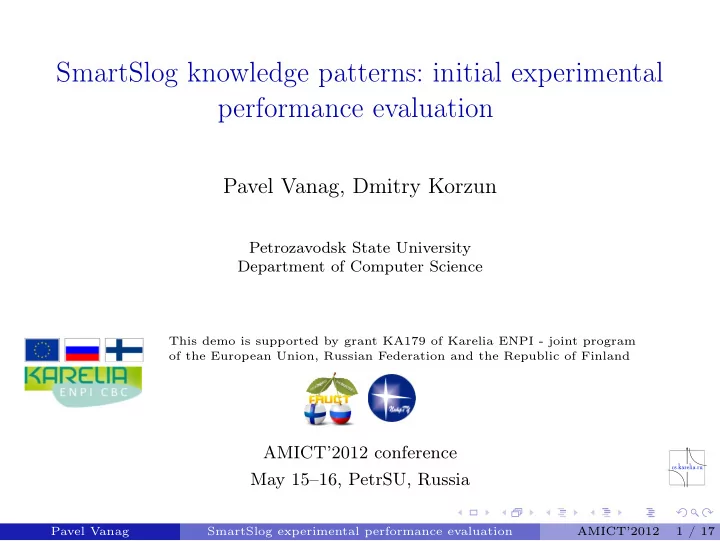

SmartSlog knowledge patterns: initial experimental performance evaluation Pavel Vanag, Dmitry Korzun Petrozavodsk State University Department of Computer Science This demo is supported by grant KA179 of Karelia ENPI - joint program of the European Union, Russian Federation and the Republic of Finland AMICT’2012 conference May 15–16, PetrSU, Russia Pavel Vanag SmartSlog experimental performance evaluation AMICT’2012 1 / 17
Table of Contents 1 Smart Spaces and Smart-M3 2 SmartSlog ADK 3 Patterns and K-graph 4 Performance evaluation 5 Conclusion Pavel Vanag SmartSlog experimental performance evaluation AMICT’2012 2 / 17
Smart Spaces and Smart-M3 Publish-subscribe system Application consists of several KPs Smart Space consists of SIBs (which maintain space content in RDF triples) KPs communicate throw SSAP protocol Pavel Vanag SmartSlog experimental performance evaluation AMICT’2012 3 / 17
SmartSlog ADK KP developer can think in abstract ontology terms with SmartSlog ADK ADK stands for Application Development Kit Ontology descripes with OWL (mapped to code: ANSI C or C#) SmartSlog uses KPI_Low library as low-level interface Pavel Vanag SmartSlog experimental performance evaluation AMICT’2012 4 / 17
SmartSlog advantages Simplifying KP code using high-level OWL terms ◮ SIB uses low-level RDF triples ◮ KP uses high-level abstractions Speed development of huge amount of KPs ◮ Multilingual support ◮ Cross-platform code generation Target devices could be low-performance ◮ Subset of ANSI C version ◮ Modest code schemes Space search ◮ Knowledge patterns... Pavel Vanag SmartSlog experimental performance evaluation AMICT’2012 5 / 17
Knowledge Patterns: filtering KP storage – ”local space” Local objects are linked with Object Properties Pavel Vanag SmartSlog experimental performance evaluation AMICT’2012 6 / 17
Knowledge Patterns: filtering Knowledge Patterns is an abstract object graph (K-graph) Pavel Vanag SmartSlog experimental performance evaluation AMICT’2012 7 / 17
Knowledge Patterns: filtering The result object would be placed to SIB Pavel Vanag SmartSlog experimental performance evaluation AMICT’2012 8 / 17
Knowledge Patterns: searching, K-graph The same pattern could be used for searching objects in the ”global” Smart Space Pattern would be mapped to RDF triples So Knowledge pattern would be used for searching triples Summary: Filtering is used for transferring/delivering necessary parts of objects to/from the smart space Searching is used to deliver (search) new objects, existing in SS Pavel Vanag SmartSlog experimental performance evaluation AMICT’2012 9 / 17
Patterns search: the most complex operation Here is a scheme how pattern based search works... Pavel Vanag SmartSlog experimental performance evaluation AMICT’2012 10 / 17
K-graph: worst-case model Size parameters for K-graph: 1 s wg – number of datatype properties that every object has (graph weight) 2 s wd – number of object properties that every object has (graph width) 3 s hg – longest path from a fixed node to other nodes (graph height) Pavel Vanag SmartSlog experimental performance evaluation AMICT’2012 11 / 17
Performance KP We developed special KP for our experiment scenario: Generates ontology with defined parameters Sends ontology Generates pattern with defined parameters Time measuring Pavel Vanag SmartSlog experimental performance evaluation AMICT’2012 12 / 17
Parameters of experiments Lets consider RDF-triples store: N – the number of triples stored in the smart space N ind – individuals It requires: N rdf RDF triples with facts about individual N ont RDF-scheme triples with high-level ontology declarations (constant) N = N ont + N ind N rdf N rdf = 1 + s wg + s wd s hg N ind = ( s wd − 1 ) / ( s wd − 1 ) Pavel Vanag SmartSlog experimental performance evaluation AMICT’2012 13 / 17
Experiments We vary s wg , s wd from 1 to 10 and s hg from 1 to 5 Pavel Vanag SmartSlog experimental performance evaluation AMICT’2012 14 / 17
Evaluation model We measure the time � � T ( s wg , s hg , s wd ) = b 0 exp b 1 s wg + b 2 s hg + b 3 s wd . Applying multiple non-linear regression analysis b 0 ≈ 11 . 582 , b 1 ≈ 0 . 034 , b 2 ≈ 5 . 538 , b 3 ≈ 0 . 388 Performance-impact proportion s hg : s wd : s wg ≈ 1 : 10 : 10 2 . Pavel Vanag SmartSlog experimental performance evaluation AMICT’2012 15 / 17
Conclusion and Plan Early measurements showed the basic trends Complexity grows with size of Knowledge Patterns Helps developer to decide the size limit of Knowledge Patterns We plan... to continue this research applying other benchmarks and models ◮ Measurments on every step ◮ Reduce connections impact further focus on typical scenarios of real-life Smart-M3 applications ◮ Patterns based algorithms ◮ Subscriptions measurments Pavel Vanag SmartSlog experimental performance evaluation AMICT’2012 16 / 17
References SmartSlog developers wiki: http://oss.fruct.org/wiki/SmartSlog/ Open source code: http://sourceforge.net/projects/smartslog/ Thank you! Pavel Vanag SmartSlog experimental performance evaluation AMICT’2012 17 / 17
Recommend
More recommend